Structure and improvisation in creative teaching /
Saved in:
| Imprint: | New York : Cambridge University Press, 2011. |
|---|---|
| Description: | xvi, 301 p. : ill. ; 24 cm. |
| Language: | English |
| Subject: | |
| Format: | Print Book |
| URL for this record: | http://pi.lib.uchicago.edu/1001/cat/bib/8450817 |
| Summary: | With an increasing emphasis on creativity and innovation in the twenty-first century, teachers need to be creative professionals just as students must learn to be creative. And yet, schools are institutions with many important structures and guidelines that teachers must follow. Effective creative teaching strikes a delicate balance between structure and improvisation. The authors draw on studies of jazz, theater improvisation and dance improvisation to demonstrate that the most creative performers work within similar structures and guidelines. By looking to these creative genres, the book provides practical advice for teachers who wish to become more creative professionals. |
|---|---|
| Item Description: | Machine generated contents note: 1. What makes good teachers great? The artful balance of structure and improvisation R. Keith Sawyer; Part I. The Teacher Paradox: 2. Professional improvisation and teacher education: opening the conversation Stacy DeZutter; 3. Creativity, pedagogic partnerships, and the improvisatory space of teaching Pamela Burnard; 4. Improvising within the system: creating new teacher performances in inner city schools Carrie Lobman; 5. Teaching for creativity with disciplined improvisation Ronald A. Beghetto and James C. Kaufman; Part II. The Learning Paradox: 6. Taking advantage of structure to improvise in instruction: examples from elementary school classrooms Frederick Erickson; 7. Breaking through the communicative cocoon: improvisation in secondary school foreign language classrooms Jürgen Kurtz; 8. Improvising with adult English language learners Anthony Perone; 9. Productive improvisation and collective creativity: lessons from the dance studio Janice E. Fournier; Part III. The Curriculum Paradox: 10. How 'scripted' materials might support improvisational teaching: insights from the implementation of a reading comprehension curriculum Annette Sassi; 11. Disciplined improvisation to extend young children's scientific thinking A. Susan Jurow and Laura Creighton; 12. Improvisational understanding in the mathematics classroom Lyndon C. Martin and Jo Towers; 13. Conclusion: presence and the art of improvisational teaching Lisa Barker and Hilda Borko. |
| Physical Description: | xvi, 301 p. : ill. ; 24 cm. |
| Bibliography: | Includes bibliographical references and index. |
| ISBN: | 9780521762519 0521762510 9780521746328 0521746329 |

